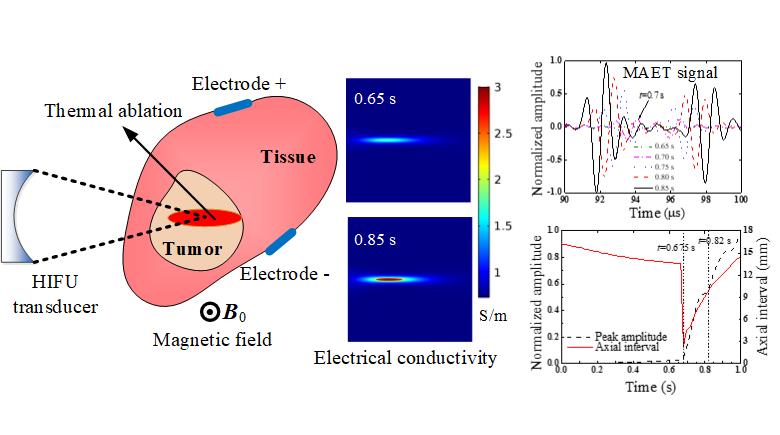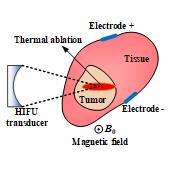
As a newly developed non-invasive treatment approach, high-intensity focused ultrasound (HIFU) has received considerable attention in the past decades due to the fast thermal coagulation of tumor cells. To ensure the treatment efficacy with minimized damage to the surrounding healthy tissues, precise temperature monitoring in the target focal area is the key issue for HIFU therapy. Meanwhile, based on the coupling of the magnetic, acoustic and electrical fields, magneto-acousto-electrical tomography (MAET) has been demonstrated to possess the capability of differentiating the conductivity variation along the acoustic path. Compared with the magnetoacoustic tomography with magnetic induction (MAT-MI), the image contrast and the spatial resolution can be improved easily by increasing the acoustic intensity at a high frequency.
By applying the temperature-conductivity relation of tissues, a non-invasive treatment efficacy evaluation method for HIFU ablation using the MAET technology is proposed in this study. With the consideration of the nonlinear effect and the thermal conduction in tissues, a two-dimensional axisymmetric model is established to simulate the real-time distributions of acoustic pressure, temperature and electrical conductivity using the KZK and Pennes equations. It is proved that the peak amplitude of the MAET signal is very small when the temperature of the focal center is less than 69 ˚C with a continuous conductivity variation, and two wave clusters are generated by the sharp conductivity variation of HIFU thermocoagulation at 69 ˚C with a minimum axial interval of one wavelength, which can be used to evaluate the size of HIFU ablation. The favorable results provide a sensitive indicator for non-invasive treatment efficacy evaluation for HIFU therapy and suggest potential applications in clinical practice.

